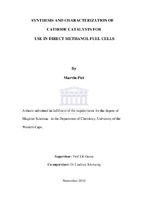| dc.description.abstract | In this work a modified polyol method was developed to synthesize in-house
catalysts. The method was modified for maximum delivery of product and proved to be quick and efficient as well as cost effective. The series of IH catalysts were characterized using techniques such as UV-vis and FT-IR spectroscopy, TEM, XRD, ICP and CV. The polyol method developed effectively reduced and deposited Pt nanoparticles onto different carbon supports. Functionalization of some of the supports was also successfully carried out through acid oxidative treatment which introduced carboxylic acid and hydroxyl groups onto the surface of the supporting material, which was
supported by FT-IR which demonstrated that there was a relative increase in
absorbance of functionalities viz., carboxylic acid (1270 cm-1) and hydroxyl groups on the surface of the acid treated MWCNT’s-F compared to the untreated MWCNT’s. Addition of a sedimentation promoter proved to increase the amount of metal deposition on the support thereby improving the loading dramatically. It was also found that addition of a specific amount of water in the polyol method allowed one to control the particle growth during the deposition phase on the various carbon supports investigated namely; XC-72 carbon, MWCNT’s and MWCNT’s-F. The in-house catalysts synthesized namely; Pt/C-IH, Pt/MWCNT’s-IH and Pt/MWCNT’s-F-IH all displayed narrow particle size distributions with average mean particle sizes of 2-5 nm, 2-6 nm and 3-6 nm respectively which was in good agreement with particle size measurements obtained from XRD using the Scherrer formula. All measured CV’s obtained for the series of IH catalysts prepared by this protocol were comparable with the commercial catalyst. The IH catalysts displayed the characteristic XRD peaks associated with Pt on carbon supports in acidic media. The ORR measurements for Pt/MWCNT’s-F-IH (functionalised) proved to be slightly superior (0.058 A/cm2) compared to that of the commercial catalyst (0.047 A/cm2) at a potential of 0.3V. This was attributed to the fact that the addition of water effectively controlled particle growth and deposition onto the support, and the fact that MWCNT’s-F offered a larger surface area and with the functionalized surface offering anchorage sites for Pt nanoparticles through carboxylic and hydroxyl functional groups. Further attempts to modify the developed polyol method using NaOAc as an
electrostatic stabilizer to control the growth of Pt nanoparticles were made. It was found that although the stabilizer employed effectively stabilized Pt nanoparticles supported on XC-72 carbon, in our hands we were not able to produce the same results in the case of Pt supported on the MWCNT’s. TEM images revealed that Pt/CNaOAc displayed narrow particle size distribution with a mean particle size of 2-5 nm whereas particle agglomeration was observed for Pt/MWCNT’s-NaOAc and Pt/MWCNT’s-F-NaOAc with a broader particle size distribution and average mean particle sizes of 2-7 and 2-8 nm in diameter respectively. The CV’s obtained for these modified IH catalysts were in the main comparable to that of the commercial catalyst. However ORR activities of the IH Pt/C-NaOAc catalysts when carefully compared to
the commercial catalyst revealed that it was indeed slightly superior (0.064 A/cm2). This is mainly attributed to the narrow particle size and even distribution of particles on the carbon support and resembled the best particle required to provide maximum activity in the ORR as a consequence of the facial kinetics involved. | en_US |

